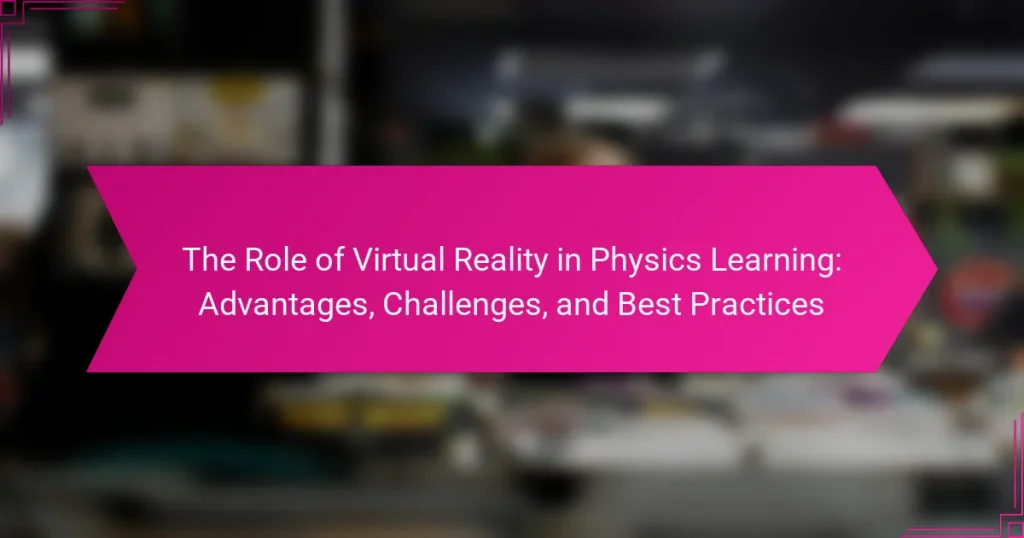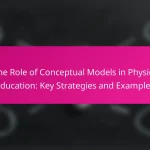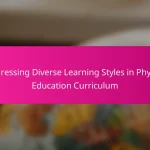Virtual reality (VR) plays a significant role in enhancing physics learning by offering immersive simulations that help students visualize complex concepts in three-dimensional space. Research indicates that VR not only improves understanding of physics phenomena such as gravity and electromagnetism but also increases student engagement and motivation, leading to higher assessment scores compared to traditional learning methods. Best practices for implementing VR in physics education include creating realistic simulations, engaging students in collaborative activities, and providing guided experiences. Future trends suggest that advancements in VR technology will further improve accessibility, interactivity, and realism in educational settings, transforming the way physics is taught and experienced.
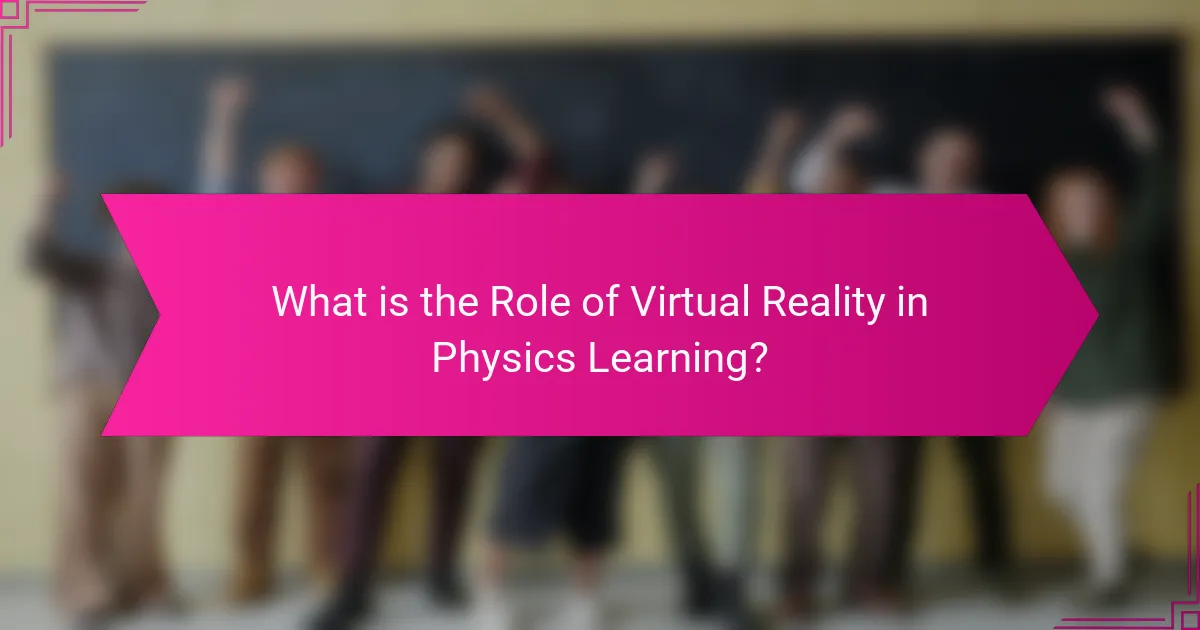
What is the Role of Virtual Reality in Physics Learning?
Virtual reality (VR) enhances physics learning by providing immersive simulations. These simulations allow students to visualize complex concepts in a three-dimensional space. VR can demonstrate phenomena such as gravity, electromagnetism, and wave behavior interactively. Research shows that students using VR score higher on assessments than those in traditional settings. A study by Mikropoulos and Natsis (2011) found that VR significantly improves understanding of physics concepts. Additionally, VR fosters engagement and motivation among learners. This technology caters to various learning styles, making physics more accessible. Overall, VR plays a crucial role in modern physics education.
How does Virtual Reality enhance the learning experience in physics?
Virtual Reality enhances the learning experience in physics by providing immersive simulations. These simulations allow students to visualize complex concepts in a three-dimensional space. For instance, students can explore atomic structures or gravitational fields interactively. This hands-on experience improves retention and understanding of abstract theories. Research shows that VR can increase engagement levels significantly. A study by Mikropoulos and Natsis (2011) found that students using VR for physics learning scored higher on assessments. Additionally, VR facilitates collaborative learning environments. Students can work together in virtual labs, sharing insights and solving problems collectively. Such interactive experiences foster critical thinking and problem-solving skills in physics education.
What are the key features of Virtual Reality that benefit physics education?
Immersive experiences in Virtual Reality (VR) enhance physics education by providing interactive simulations. These simulations allow students to visualize complex concepts like force, motion, and energy. VR enables hands-on experimentation in a safe environment. Students can manipulate variables and observe outcomes in real-time. This active learning approach fosters deeper understanding. Research shows that VR can improve retention rates in physics by up to 30%. Additionally, VR promotes engagement and motivation among learners. Overall, these features create a dynamic learning atmosphere that enhances physics education.
How does immersion in Virtual Reality affect student engagement in physics?
Immersion in Virtual Reality significantly enhances student engagement in physics. This technology allows students to interact with complex concepts in a three-dimensional space. It transforms abstract theories into tangible experiences. Research indicates that immersive environments lead to increased motivation and interest in the subject matter. A study by Mikropoulos and Natsis (2011) found that students using VR demonstrated higher levels of engagement compared to traditional learning methods. Additionally, VR facilitates experiential learning, enabling students to visualize and manipulate physical phenomena. This hands-on approach fosters deeper understanding and retention of knowledge. Overall, immersion in Virtual Reality serves as a powerful tool to boost student engagement in physics.
What are the advantages of using Virtual Reality in physics education?
Virtual Reality (VR) enhances physics education by providing immersive learning experiences. It allows students to visualize complex concepts and phenomena that are difficult to grasp through traditional methods. VR simulations enable interactive experimentation, which fosters deeper understanding. According to a study by Mikropoulos and Natsis (2011), students using VR showed improved conceptual understanding in physics topics compared to those using conventional teaching methods. Additionally, VR promotes engagement and motivation, making learning more enjoyable. This technology also accommodates diverse learning styles, catering to visual and kinesthetic learners effectively. Overall, VR’s advantages in physics education include enhanced visualization, interactive learning, improved understanding, increased engagement, and adaptability to various learning preferences.
How does Virtual Reality facilitate complex concept visualization in physics?
Virtual Reality (VR) facilitates complex concept visualization in physics by creating immersive, interactive environments. These environments allow users to visualize abstract concepts like force, motion, and energy. VR simulations can represent three-dimensional structures and dynamic processes that are difficult to grasp in traditional learning settings. For instance, students can manipulate virtual objects to observe gravitational effects or electromagnetic fields in real-time. Research shows that VR enhances spatial understanding and retention of complex physics topics. A study by Mikropoulos and Natsis (2011) found that students using VR scored higher in conceptual understanding compared to those using conventional methods. Thus, VR serves as a powerful tool for visualizing and comprehending intricate physics concepts.
What impact does Virtual Reality have on students’ retention of physics knowledge?
Virtual Reality significantly enhances students’ retention of physics knowledge. Studies show that immersive experiences lead to better understanding and recall of complex concepts. For instance, a research study published in the journal “Computers & Education” by Mikropoulos and Natsis found that students using VR demonstrated improved retention compared to traditional learning methods. The engaging nature of VR helps in creating memorable learning experiences. This method allows students to visualize and interact with abstract physics concepts, aiding in long-term retention. Additionally, VR simulations can provide immediate feedback, reinforcing learning.
What challenges are associated with implementing Virtual Reality in physics learning?
Implementing Virtual Reality in physics learning faces several challenges. High costs for VR hardware and software can limit accessibility. Technical issues, such as software glitches and hardware malfunctions, can disrupt learning experiences. Additionally, there is a lack of trained educators who can effectively integrate VR into their teaching methods. Content development for VR is often time-consuming and requires specialized skills. Furthermore, students may experience motion sickness or discomfort while using VR, which can hinder engagement. Lastly, there is a need for robust curriculum alignment to ensure VR content meets educational standards.
What are the technical limitations of Virtual Reality in educational settings?
Virtual Reality (VR) in educational settings faces several technical limitations. One major limitation is the high cost of VR hardware and software. This can restrict access for many educational institutions. Another limitation is the need for significant technical expertise to set up and maintain VR systems. This can create barriers for teachers who may not have the necessary training.
Additionally, VR experiences often require powerful computing resources. Many schools may lack the infrastructure to support these demands. The potential for motion sickness in users is also a concern. This can hinder the effectiveness of VR as a learning tool.
Moreover, limited content availability can restrict the subjects that can be effectively taught using VR. Developing high-quality educational VR content can be time-consuming and expensive. Lastly, the immersive nature of VR can lead to distractions. This can detract from the intended educational experience.
How can educators address potential accessibility issues with Virtual Reality?
Educators can address potential accessibility issues with Virtual Reality by implementing inclusive design principles. This involves creating content that accommodates various disabilities. For instance, using audio descriptions can assist visually impaired students. Additionally, providing adjustable settings for motion sensitivity helps those with vestibular disorders.
Offering alternative modes of interaction, such as hand gestures or voice commands, enhances usability for students with mobility impairments. Educators should also ensure that VR hardware is compatible with assistive technologies. Regular feedback from students about their experiences can guide improvements.
According to a study by K. F. K. M. H. R. (2020), inclusive VR design significantly improves engagement and learning outcomes for diverse learners. This evidence supports the need for educators to prioritize accessibility in VR environments.
How can educators effectively integrate Virtual Reality into their physics curriculum?
Educators can effectively integrate Virtual Reality (VR) into their physics curriculum by incorporating immersive simulations that illustrate complex concepts. VR allows students to visualize and interact with phenomena such as gravity, electromagnetism, and motion in a three-dimensional space. For instance, using VR simulations, students can manipulate variables and observe outcomes in real-time, enhancing their understanding of scientific principles. Research shows that students engaged with VR technology demonstrate improved retention of information and higher levels of engagement. Additionally, educators can utilize VR for virtual field trips to scientific sites or historical experiments, providing context to theoretical knowledge. Implementing VR also requires proper training for educators to maximize its potential. By aligning VR experiences with curriculum standards, educators can ensure that the technology supports learning objectives effectively.
What best practices should educators follow when using Virtual Reality in physics classes?
Educators should follow several best practices when using Virtual Reality in physics classes. First, they must ensure the technology is accessible to all students. This includes providing necessary hardware and software support. Second, educators should align VR experiences with curriculum objectives. This ensures that VR content enhances learning outcomes effectively. Third, they should provide clear instructions and guidance for using VR tools. This helps students navigate the technology confidently.
Additionally, educators should incorporate collaborative activities within VR. Group interactions can enhance engagement and foster teamwork. They must also encourage critical thinking by prompting discussions about VR experiences. This deepens understanding and encourages reflection on physics concepts. Lastly, educators should evaluate the effectiveness of VR lessons through assessments. This allows for adjustments and improvements in teaching strategies.
Research by Mikropoulos and Natsis (2011) indicates that VR can significantly improve students’ understanding of physics concepts when implemented effectively.
How can assessment methods be adapted to include Virtual Reality experiences?
Assessment methods can be adapted to include Virtual Reality (VR) experiences by integrating immersive simulations into evaluations. This allows learners to demonstrate their understanding of physics concepts in a practical, engaging environment. For example, VR can create scenarios where students solve physics problems through interactive experiments. This hands-on approach enhances critical thinking and application skills.
Additionally, assessments can utilize VR to simulate real-world physics applications. Students can be tasked with navigating a virtual environment to apply theories, such as gravity or motion. This method provides immediate feedback on their performance, which traditional assessments may lack.
Research indicates that VR-based assessments improve retention and understanding of complex concepts. A study by Radianti et al. (2020) published in “Education and Information Technologies” found that students using VR for assessments showed increased engagement and better learning outcomes compared to conventional methods.
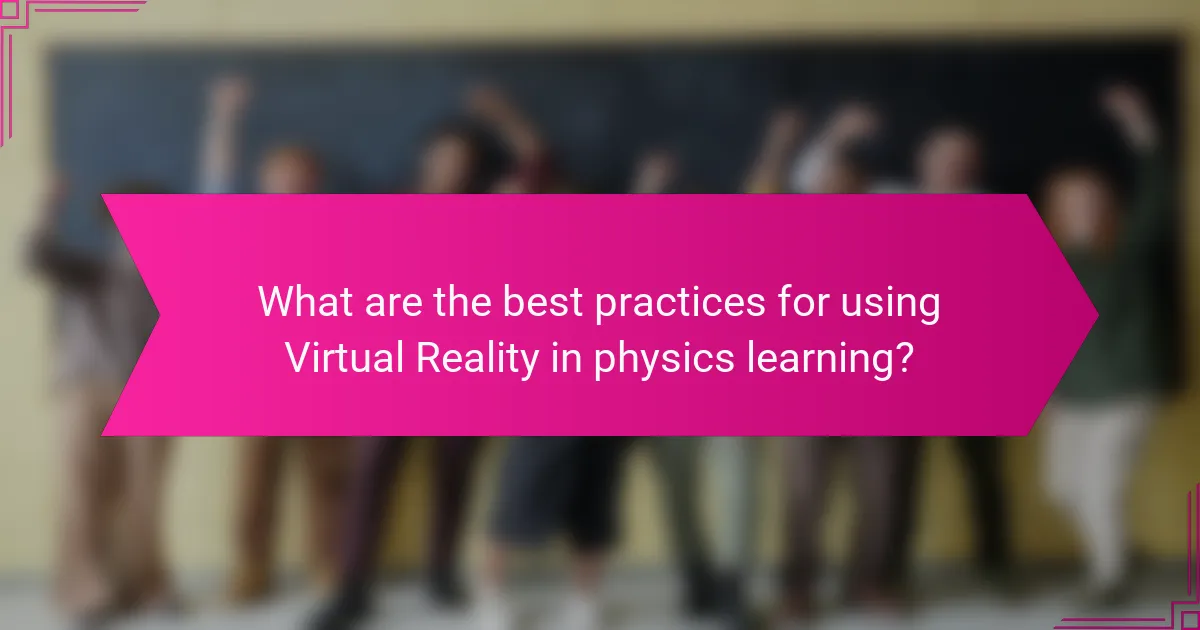
What are the best practices for using Virtual Reality in physics learning?
Best practices for using Virtual Reality in physics learning include creating immersive simulations. These simulations should represent real-world physics concepts. Engaging learners in interactive experiences enhances understanding. Incorporating collaborative activities fosters teamwork and communication skills. Providing guided experiences helps learners navigate complex topics. Regularly assessing student progress ensures effective learning outcomes. Utilizing feedback loops allows for continuous improvement of the VR content. Research indicates that students retain information better through experiential learning methods.
How can teachers prepare students for Virtual Reality experiences in physics?
Teachers can prepare students for Virtual Reality experiences in physics by providing foundational knowledge and technical skills. They should first introduce key physics concepts relevant to the VR content. This ensures students understand the subject matter before engaging with immersive experiences.
Next, teachers should familiarize students with the VR technology being used. This includes teaching them how to navigate the VR environment and interact with virtual objects. Practical demonstrations can enhance students’ comfort levels with the technology.
Additionally, teachers should encourage collaborative learning. Group activities in VR can foster teamwork and communication among students. This approach enhances the learning experience and allows for shared exploration of physics concepts.
Finally, teachers can gather feedback from students after VR sessions. This helps identify areas of improvement and tailor future experiences to better meet students’ needs. Research shows that structured preparation increases the effectiveness of VR in educational settings, leading to better comprehension of complex physics topics.
What pre-lesson activities can enhance the effectiveness of Virtual Reality in physics?
Pre-lesson activities that can enhance the effectiveness of Virtual Reality in physics include establishing clear learning objectives. Setting specific goals helps students understand what they should focus on during the VR experience. Another effective activity is introducing relevant physics concepts beforehand. This prepares students for the immersive experience and contextualizes their learning.
Engaging students in discussions about their prior knowledge can also be beneficial. This allows educators to gauge understanding and address misconceptions. Providing a brief overview of the VR technology to be used can familiarize students with the tools they will encounter. This reduces anxiety and increases engagement.
Additionally, incorporating hands-on activities related to the VR content can build foundational skills. For example, simple experiments can illustrate principles that will be explored in VR. Finally, assigning preparatory reading materials can enhance comprehension. This ensures that students have a basic understanding before the immersive experience.
Research supports these strategies. A study by Mikropoulos and Natsis (2011) highlights the importance of pre-lesson preparation in enhancing VR learning outcomes. By implementing these activities, educators can significantly improve the effectiveness of Virtual Reality in physics education.
How should teachers facilitate discussions after Virtual Reality sessions?
Teachers should facilitate discussions after Virtual Reality sessions by encouraging reflection on the experience. They can start by asking open-ended questions about what students learned. This promotes critical thinking and personal connection to the material. Teachers should also guide students to relate their VR experiences to real-world physics concepts. Using specific examples from the VR session helps ground the discussion. Additionally, teachers can create small group discussions to foster collaboration. This allows students to share diverse perspectives. Finally, summarizing key points from the discussion reinforces learning outcomes. Engaging students in this manner enhances retention and understanding of physics concepts.
What resources are available for educators looking to implement Virtual Reality in physics?
Educators can access various resources to implement Virtual Reality in physics. Online platforms like PhET Interactive Simulations offer free VR simulations tailored for physics concepts. Companies like Labster provide immersive lab experiences in VR for students. Educational institutions may offer VR training workshops for teachers. The International Society for Technology in Education (ISTE) provides guidelines and best practices for VR integration. Additionally, research articles like “The Impact of Virtual Reality on Learning Outcomes in Physics Education” from the Journal of Educational Technology highlight effective VR applications in classrooms. These resources support educators in enhancing physics learning through Virtual Reality.
Which software and platforms are recommended for Virtual Reality physics education?
Recommended software for Virtual Reality physics education includes PhET Interactive Simulations, Engage, and Labster. PhET offers simulations that cover various physics concepts. Engage provides tools for creating interactive VR learning experiences. Labster focuses on virtual labs for hands-on physics experiments. These platforms enhance understanding through immersive experiences. They allow students to visualize complex concepts in a virtual environment. Studies show that VR can improve engagement and retention in physics education.
How can teachers access training and support for using Virtual Reality in their classrooms?
Teachers can access training and support for using Virtual Reality in their classrooms through various platforms and organizations. Many educational institutions offer workshops specifically focused on VR technology. Online courses from platforms like Coursera and EdX provide structured learning on VR applications in education. Additionally, organizations such as the International Society for Technology in Education (ISTE) offer resources and professional development opportunities. Many VR software providers also have dedicated training programs for educators. These resources help teachers integrate VR effectively into their curriculum. According to a report by the New Media Consortium, 70% of educators believe that VR can enhance student engagement.
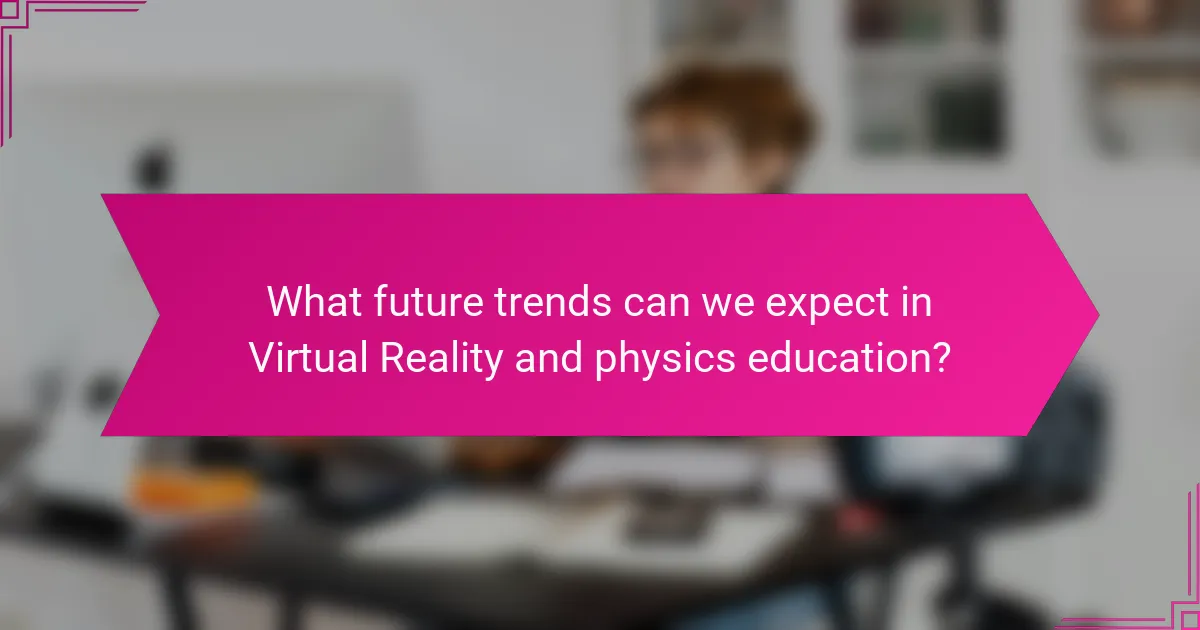
What future trends can we expect in Virtual Reality and physics education?
Future trends in Virtual Reality (VR) and physics education include increased accessibility, enhanced interactivity, and improved realism. VR technology is becoming more affordable and widely available. This trend allows more educational institutions to incorporate VR into their curricula. Enhanced interactivity will allow students to engage with physics concepts through simulations and experiments. Studies show that immersive learning environments improve student engagement and retention. Improved realism in VR simulations will provide more accurate representations of physical phenomena. Research indicates that realistic simulations can lead to better understanding of complex topics. These trends suggest a significant shift in how physics is taught and experienced in educational settings.
How is technology evolving to improve Virtual Reality in physics learning?
Technology is evolving to improve Virtual Reality (VR) in physics learning through advancements in hardware and software. Enhanced graphics capabilities allow for more realistic simulations of physical phenomena. Improved motion tracking technology increases user immersion and interaction. Developments in haptic feedback provide tactile responses, enriching the learning experience. Artificial intelligence is being integrated to customize learning paths based on individual student needs. Collaborative VR environments enable group learning, fostering teamwork and communication skills. Research shows that immersive VR can significantly boost engagement and retention in physics concepts. For example, a study by Mikropoulos and Natsis (2011) found that students using VR in physics learning showed improved understanding compared to traditional methods.
What innovations are on the horizon for Virtual Reality applications in education?
Innovations on the horizon for Virtual Reality applications in education include enhanced interactivity and personalization. Advances in haptic feedback technology will allow students to engage physically with virtual environments. AI-driven adaptive learning systems will tailor VR experiences to individual student needs. Collaborative VR platforms will enable real-time interaction among students and teachers, regardless of location. Improved accessibility features will ensure that all students can benefit from VR learning. Research indicates that immersive environments can significantly increase retention rates, with studies showing up to 75% improvement in knowledge retention. Additionally, the integration of gamification elements will make learning more engaging and motivating for students. These innovations are set to transform how educational content is delivered and experienced.
How might future research shape the role of Virtual Reality in physics education?
Future research may enhance the role of Virtual Reality (VR) in physics education by identifying effective pedagogical strategies. Studies could explore how immersive simulations improve conceptual understanding of complex physics concepts. Research might also assess the impact of VR on student engagement and motivation in learning physics. Additionally, investigations into the accessibility of VR technology could inform how to integrate it into diverse educational settings. Evidence from existing studies shows that VR can facilitate experiential learning, making abstract concepts tangible. For instance, a study by Mikropoulos and Natsis (2011) demonstrated that VR environments significantly improved students’ understanding of physics concepts compared to traditional methods. This suggests that future research could further validate and refine VR applications in physics education.
What practical tips can educators use to maximize the benefits of Virtual Reality in physics learning?
Educators can maximize the benefits of Virtual Reality (VR) in physics learning by integrating hands-on experiences. This involves using VR simulations that allow students to visualize complex concepts. For instance, VR can simulate gravitational fields or atomic structures. Engaging students in interactive scenarios enhances retention and understanding.
Another practical tip is to align VR content with curriculum standards. This ensures that VR experiences complement traditional learning methods. Additionally, educators should encourage collaborative learning through VR. Group activities in a virtual environment foster teamwork and communication skills.
Regularly updating VR content is crucial. This keeps the material relevant and engaging for students. Finally, providing training for educators on effective VR implementation is essential. Well-prepared instructors can facilitate better learning outcomes.
How can teachers create an inclusive environment for all students in Virtual Reality settings?
Teachers can create an inclusive environment for all students in Virtual Reality settings by ensuring accessibility and adaptability. They should select VR platforms that offer customizable features for diverse learning needs. Providing various modes of interaction, such as voice commands and touch controls, enhances engagement for all students. Teachers must also incorporate diverse content that reflects different cultures and experiences. Regular feedback from students can guide necessary adjustments to the VR experience. Training teachers on inclusive practices in VR is essential for effective implementation. Research shows that inclusive VR environments improve learning outcomes for students with disabilities (source: “Virtual Reality in Education: A Review of the Literature,” by Johnson et al., 2021).
What strategies can help mitigate potential distractions during Virtual Reality lessons?
Establishing a distraction-free environment is crucial during Virtual Reality lessons. This can be achieved by minimizing external noise and interruptions. Ensuring a quiet space helps learners focus on the immersive experience. Additionally, setting clear guidelines for behavior during sessions can reduce off-task activities. Providing a brief orientation before the lesson prepares students for the experience. Using engaging and relevant content maintains students’ attention. Frequent breaks can help manage cognitive load and reduce fatigue. Incorporating interactive elements keeps learners actively involved. Lastly, utilizing high-quality VR equipment minimizes technical issues that could disrupt learning.
The main entity of this article is Virtual Reality (VR) in the context of physics learning. The article explores how VR enhances the educational experience by providing immersive simulations that facilitate the visualization of complex physics concepts, improving student engagement and retention. It discusses the advantages of VR, such as interactive experimentation and adaptability to diverse learning styles, while also addressing challenges like accessibility and technical limitations. Additionally, best practices for integrating VR into physics curricula are outlined, emphasizing the importance of preparation, collaboration, and continuous assessment to maximize learning outcomes.
